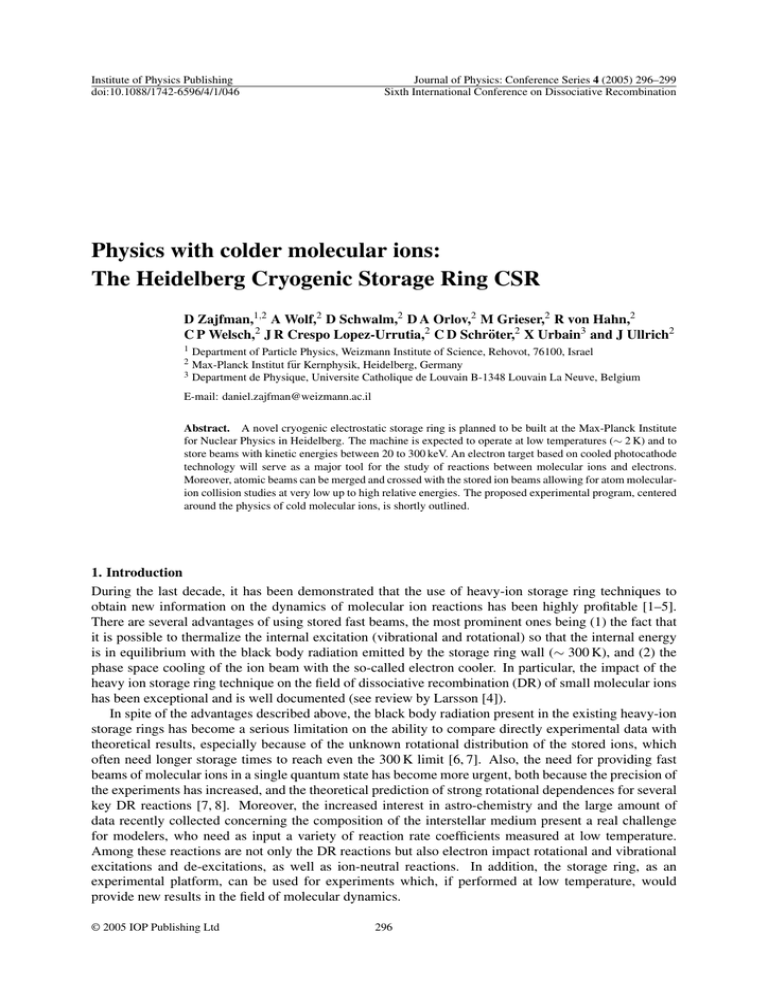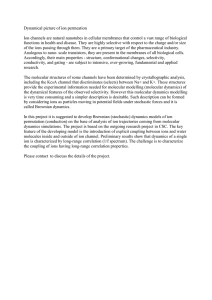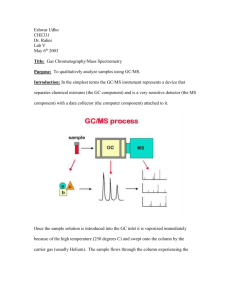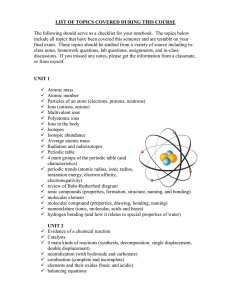Physics with colder molecular ions: The Heidelberg Cryogenic
advertisement

Institute of Physics Publishing doi:10.1088/1742-6596/4/1/046 Journal of Physics: Conference Series 4 (2005) 296–299 Sixth International Conference on Dissociative Recombination Physics with colder molecular ions: The Heidelberg Cryogenic Storage Ring CSR D Zajfman,1,2 A Wolf,2 D Schwalm,2 D A Orlov,2 M Grieser,2 R von Hahn,2 C P Welsch,2 J R Crespo Lopez-Urrutia,2 C D Schröter,2 X Urbain3 and J Ullrich2 1 2 3 Department of Particle Physics, Weizmann Institute of Science, Rehovot, 76100, Israel Max-Planck Institut für Kernphysik, Heidelberg, Germany Department de Physique, Universite Catholique de Louvain B-1348 Louvain La Neuve, Belgium E-mail: daniel.zajfman@weizmann.ac.il Abstract. A novel cryogenic electrostatic storage ring is planned to be built at the Max-Planck Institute for Nuclear Physics in Heidelberg. The machine is expected to operate at low temperatures (∼ 2 K) and to store beams with kinetic energies between 20 to 300 keV. An electron target based on cooled photocathode technology will serve as a major tool for the study of reactions between molecular ions and electrons. Moreover, atomic beams can be merged and crossed with the stored ion beams allowing for atom molecularion collision studies at very low up to high relative energies. The proposed experimental program, centered around the physics of cold molecular ions, is shortly outlined. 1. Introduction During the last decade, it has been demonstrated that the use of heavy-ion storage ring techniques to obtain new information on the dynamics of molecular ion reactions has been highly profitable [1–5]. There are several advantages of using stored fast beams, the most prominent ones being (1) the fact that it is possible to thermalize the internal excitation (vibrational and rotational) so that the internal energy is in equilibrium with the black body radiation emitted by the storage ring wall (∼ 300 K), and (2) the phase space cooling of the ion beam with the so-called electron cooler. In particular, the impact of the heavy ion storage ring technique on the field of dissociative recombination (DR) of small molecular ions has been exceptional and is well documented (see review by Larsson [4]). In spite of the advantages described above, the black body radiation present in the existing heavy-ion storage rings has become a serious limitation on the ability to compare directly experimental data with theoretical results, especially because of the unknown rotational distribution of the stored ions, which often need longer storage times to reach even the 300 K limit [6, 7]. Also, the need for providing fast beams of molecular ions in a single quantum state has become more urgent, both because the precision of the experiments has increased, and the theoretical prediction of strong rotational dependences for several key DR reactions [7, 8]. Moreover, the increased interest in astro-chemistry and the large amount of data recently collected concerning the composition of the interstellar medium present a real challenge for modelers, who need as input a variety of reaction rate coefficients measured at low temperature. Among these reactions are not only the DR reactions but also electron impact rotational and vibrational excitations and de-excitations, as well as ion-neutral reactions. In addition, the storage ring, as an experimental platform, can be used for experiments which, if performed at low temperature, would provide new results in the field of molecular dynamics. © 2005 IOP Publishing Ltd 296 297 In the following, we describe in short the plans which are presently being pursued at the Max-Planck Institute for Nuclear Physics, Heidelberg, for building a next generation, cryogenic storage ring (CSR). We mainly focus on molecular ion physics experiments that could run on such a machine; additional scientific programs related to highly charged ions and fast ion-neutral collision dynamics through the use of an in-ring reaction microscope are only shortly mentioned. 2. The cryogenic storage ring The electrostatic storage ring is planned to be cooled down to a temperature of ∼ 2 K. This has two important implications: First, it will lead to extremely low rest-gas pressures which allow to reach the long storage times needed to complete radiative rotational cooling, and second, it will drastically reduce the blackbody radiation which makes it possible to achieve and store molecular ions in their rotational ground state. Moreover, controlled changes of the temperature will allow for measurements such as reaction rates to be performed under well defined temperature conditions. The energy of the stored ions is foreseen to be adjustable between ∼ 20 keV and ∼ 300 keV (per charge) by using an internal RF cavity, and since the ring will only employ electrostatic fields there is no mass limit for the storage of heavy molecular species. The new storage ring will be equipped with an electron target, mounted in a merged beam configuration in one of the arms of the CSR, which is employing the cryogenic photocathode technique developed in Heidelberg [9] to produce extremely cold electron beams. Such an electron target has been recently installed at the test storage ring (TSR) in Heidelberg and has already demonstrated superior transverse energy resolution (∼ 500 µ eV). Preliminary calculations have also shown that at least for light ions phase space cooling with such an electron beam is possible. Additionally, it will be possible to perform reaction studies with fast neutral atomic beams in a merged beam geometry with the stored, state selected molecular ion beam. The atomic beam will be produced by photodetachment of negative ions extracted from an external ion source, and its velocity will be tunable so that cross section measurements can be carried out at very low relative energies. Similarly, a crossed atomic or molecular beam target equipped with an electron and ion momentum imaging system will be installed to study atomic multi-electron reaction dynamics, taking advantage of the high flux of stored, low-energy ions. Ion detection at keV energies is usually more difficult than in the MeV range subtended in magnetic storage rings, where standard silicon or scintillation detectors can be used to count the reaction products with 100% efficiency. For the CSR we are therefore making preparations to use beside the standard technique of micro-channel plate detection novel cryogenic detectors, which fit well with the cold ring environment. These detectors [10], which are magnetic micro-calorimeters, have the advantage of reaching 100 % detection efficiencies even for very low kinetic energy particles, so that absolute cross section measurements can be carried out. The overall circumference of the storage ring, with its detailed layout presently under discussion, is envisaged to be about 35 m. Special care has to be taken to minimize the cryogenic power needed for keeping the ring at the requested low temperature and to secure the required low rest gas pressure, and different approaches are currently under investigation. A ∼ 3 m long prototype is planned to be constructed in order to test these different options. 3. Physics: The quantum reaction dynamics of cold molecular ions The proposed development will point out new directions for the storage of atomic and molecular ions and related techniques such as: (a) strongly increased storage times; (b) an almost radiation free environment; (c) lower beam velocities; (d) storage and cooling of ions in very high charge states at low beam velocity; (e) storage of molecular species in a wide mass range; (f) electron beam technique and (g) low temperature detector technology. After completion of the basic setup a versatile, high performance cryogenic cooler ring will enable a large experimental program, extending into many areas. Some of the 298 anticipated new research opportunities are described in the following. The electron impact rotational and vibrational excitation of cold molecular ions is a central process in the interstellar medium. Although many theoretical calculations exist [11], there is no experimental data available for these reactions. Initial results [12] obtained at the TSR storage ring for vibrational de-excitation have shown large discrepancies with existing calculations, and further work is needed to asses the reasons behind this disagreement. The experiments will allow direct comparison with theory, and will help to improve the modeling of interstellar molecular clouds. We plan to study in details the rotational effects in the process of dissociative recombination of molecular ions with low temperature electrons (< 10 K) including aspects related to the many-particle dissociation dynamics and the chemical branching ratio. Moreover, for cold molecular ions, the high resolution electron target (< 1 meV) will allow for the probing of single Rydberg resonances for fully resolved rotational initial quantum states. Further, we plan to study the electron induced rotational and vibrational excitation of molecular ions, on a state to state basis, using both laser tagging and imaging technology. Infrared laser studies on the stored molecular ions will allow to tag specific states or to perform direct population transfer. As the molecular ions are in their ground rotational states, efficient production of single excited states is possible, hence opening the way toward controlling the internal excitation of the stored ions. For larger molecular systems, such as ionic clusters, the low temperature environment will allow to investigate weakly bound systems (e.g. hydrogen clusters) and to measure their properties and cooling mechanism. Evaporation and fragmentation processes induced either by low energy electrons or by photo-excitation will be studied in detail and will provide new insight in the many-body dissociation dynamics of large systems [14]. At even larger scale, the possibility to store large molecular ions of biological relevance in the cryogenic electrostatic storage ring will allow to study some of their properties and differences between gas-phase, liquid phase and true biological environments [15]. The interaction between these bio-molecules and low energy electrons or photons will allow us to probe bond breaking processes [16] and to study the so called collision activated dissociation. The main advantage here is that all products (charged and neutral) can be analyzed using the new superconductor detection technique, so that we expect to be able to identify the fragmentation pattern in a unique way. As pointed out above, the CSR will be equipped with a merged (neutral) atomic beam, where low velocity atom - molecular ion collisions will be studied. With such a setup we hope to clarify the effect of rotations in low temperature atom - molecular ion exchange collisions, and go beyond the classic ion-induced dipole Langevin-type description which is implying an inverse velocity dependence for the cross section [13]. Deuteration processes, which are critical in the modeling of interstellar clouds, will be measured under conditions which are equivalent to those existing in space. Since the total available energy in these reactions is already significantly changed by the excitation of the lowest rotational or fine structure states of the reactants, the low temperature is critical to achieve reliable results. The CSR is also planned to be used for the storage of slow, very highly charged ions. The expected low pressure in the ring should allow for lifetimes which are sufficiently long so that experiments with these ions and the cold atomic target can be carried out. These experiments will permit the study of many electron transfer reactions with unsurpassed precision. 4. Summary In summary, the completed cryogenic storage ring will be a unique facility where many aspects related to the dynamics of ionic systems, both small and large, can be probed. The interactions of highly charged ions and cold molecular ions with photons, electrons, neutral atoms and strong fs-lasers, in connection with kinematically complete detection of all products, constitute a unique laboratory yielding state-tostate reconstruction of these elementary processes under controlled conditions. 299 References [1] [2] [3] [4] [5] [6] [7] [8] [9] [10] [11] [12] [13] [14] [15] [16] Habs D et al. 1989 Nucl. Inst. and Meth. B 43 390 Strömholm C, Semaniak J, Rosen S, Danared H, Datz S, van der Zande W and Larsson M 1996 Phys. Rev. A 54 3086 Andersen L H, Andersen T and Hvelplund P 1998 Advances in Atomic Molecular And Optical Physics 38 155 Larsson M 2000 Adv. Ser. in Phys. Chem. vol 10: Photoionization and Photodetachment ed Ng C-Y (Singapore: World Scientific) Andersen L H 2001 Photonic, Electronic and Atomic Collisions, Proc. ICPEAC XXII, Santa Fe, New Mexico ed Burgdörfer et al. (Princeton: Rinton Press) p 292 Lammich L et al. 2003 Phys. Rev. Lett. 91 143201 Carata L, Orel A E, and Suzor-Weiner A 1999 Phys. Rev. A 59 2804 Kokoouline V and Greene C H 2004 Phys. Rev. A 69 032711 Orlov D A, Hoppe M, Weigel U, Schwalm D, Terekhov A S and Wolf A 2001 Appl. Phys. Lett. 78 2721 Enss C 2000 Physica B 280 515 Faure A and Tennyson J 2002 J. Phys. B: At. Mol. Opt. Phys. 35 3945 Krohn S, Amitay Z, Baer A, Zajfman D, Lange M, Knoll L, Levin J, Schwalm D, Wester R and Wolf A 2000 Phys. Rev. A 62 032713 Tossi P et al. 1991 Phys. Rev. Lett. 67 1254 Hansen K, Andersen J U, Hvelplund P, Møller S P, Pedersen U V and Petrunin V V 2001 Phys. Rev. Lett. 87 123401 Tanabe T and Noda K 2003 Nucl. Instrum. Methods in Physics Research A 496 233 Sanche L 1994 Photonic, Electronic and Atomic Collisions, Proc. ICPEAC XXII, Santa Fe, New Mexico ed Burgdörfer et al. (Princeton: Rinton Press) p 50




